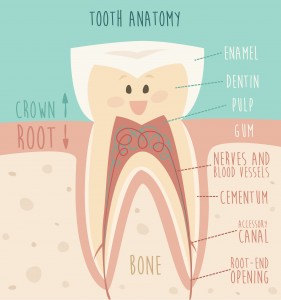The Anatomy of a Tooth: Vital or Non-vital
 Inside every tooth is an area that contains a material called pulp. The pulp houses a network of nerves and blood vessels that keep the tooth alive. Pulp protects the tooth in many ways, from supplying it with moisture and nutrients, to acting as a sensor. But if your tooth is damaged, the pulp may no longer receive blood, and you’ll be left with a dead tooth.
Inside every tooth is an area that contains a material called pulp. The pulp houses a network of nerves and blood vessels that keep the tooth alive. Pulp protects the tooth in many ways, from supplying it with moisture and nutrients, to acting as a sensor. But if your tooth is damaged, the pulp may no longer receive blood, and you’ll be left with a dead tooth.
Pulp acts as a sensor by telling the brain that there is a problem with the tooth. It does this by sending signals of pain to the brain, telling it that there’s a problem. These signals include:
- too much pressure on the tooth
- extremes in hot or cold
- trauma, like a heavy blow against the tooth
- decay, inflammation or infection in or around the tooth
When the trauma or decay is severe, the blood vessels inside the blood supply to the tooth can be cut off and the tooth “dies.” Dentists call this a non-vital tooth. A vital tooth is what dentists call a tooth that has properly functioning cells and nerves. In other words, the tooth is “alive.” However, a non-vital tooth, with no functioning blood vessels or nerves is dead.
Signs of a dead tooth
 Sometimes a tooth will die and you may not experience any symptoms. Signs that may present themselves are:
Sometimes a tooth will die and you may not experience any symptoms. Signs that may present themselves are:
- Discoloration: a tooth may appear yellow, grey, or black. Once the dead tooth becomes discolored it remains that way.
- Pain: Pain can occur if an infection is present or the nerve is dying.
- Infection: An infection can cause swelling, bad odor, or bad taste in the mouth because of pus seeping through or around the area.
But even with no signs or symptoms, a dead tooth can be assessed at a regular dental checkup.
Treating a dead tooth
If you leave a dead tooth in place for long, the inside of the tooth becomes a breeding ground for further decay and infection.
 Here are several options for treating a dead tooth:
Here are several options for treating a dead tooth:
- Dental implant: your prosthodontist will remove the tooth, then clean the area, and finally place an implant in place of the dead tooth.
- Root Canal: the dentist cleans out the infected pulp, removes the root of the dead tooth and saves the part of the tooth above the gum line that is not infected. A dental crown is placed over the tooth to match the surrounding teeth.
- Veneer: in some cases, like trauma without infection, a veneer can be placed over the discolored tooth. This can be a good solution for discolored front teeth.
- Tooth Removal: removing a tooth, without replacing it, is an option, but can create some problems of its own. Once a tooth is removed, bone loss occurs, and facial bone structure begins to collapse. Tooth removal, followed by the placement of a dental implant, is a good option.
Taking care of a dead tooth
 First, an overall dental assessment is the best place to start, ensuring your teeth are as healthy as they can be.
First, an overall dental assessment is the best place to start, ensuring your teeth are as healthy as they can be.
Many dental problems go unnoticed…until they cause pain and discomfort. Dr. Stone encourages all of his patients to come in for regular checkups to learn as much as possible about how to prevent problems, so you can keep your teeth for a lifetime!
Contact Us for an appointment.
Call Us: 954-568-9100
Contact us if you have a question or to
schedule your complimentary consultation!
